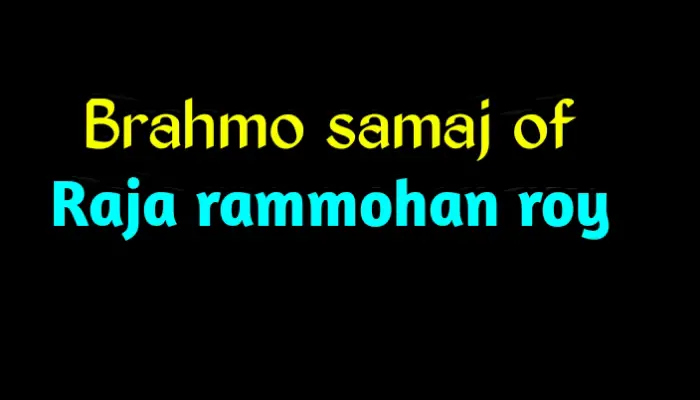THE BRAHMO SAMAJ
The Brahmo Samaj of Raja Rammohan Roy was a spiritual institution or agency of socio-religious reformation in modern India. This brain-child of Raja Rammohan Roy was both a religious order and a reformation movement. It was a part and an active agency of Renaissance movement and an ideological revolution. It was an organised movement in the pursuit of humanitarian goals. In the year 1828, The Brahmo Samaj was established by Raja rammohan roy but it started functioning from the year 1830. Important personalities like Keshab Chandra Sen, Devendranath Tagore, Jagadish Chandra Bose, Rabindranath Tagore etc. had worked in the spirit of Brahmo Samaj, the maxim of which was, “Worship and Adoration of Eternal, Unsearchable and Immutable Being who is the Author and Preserver of the Universe.”
 |
| Brahmo samaj of raja rammohan roy |
Meaning of Brahmin:-
“Brahmo’ means the Absolute or the Eternal Being or the supreme soul. Thus, the meaning of Brahmo Samaj is the congregation of the Absolute or the supreme soul. The Samaj aimed at offering worship to the one and the only one invisible God. The Brahmo or the Supreme Being had no title or designation. The Samaj rejected idolatry, polytheism and offering of sacrifices to God. It was open to men of all castes, colours, creeds, religions and countries without any distinction. It aimed at generating and promoting all human virtues such as benevolence, piety etc. It had the intention of creating a universal religion consisting of humanism and cosmopolitanism. It believed in the fundamental principle-‘fatherhood of god and brotherhood of man’ as preached by Kabir and Nanak earlier.
Aim of the Brahmo Samaj:-
The idea of establishing the Brahmo Samaj by Raja Rammohan Roy was due to his intense desire to purify the then Indian society which was almost in a ‘dark age’. He had a revolutionary zeal to reform the society of its socio-religious evils. At that time Hinduism was in a precarious and degenerating condition. It was the handmaid of the corrupt priestly class which was exploiting the religious sentiment of the people. They had to perform expensive religious ceremonies, rituals, offerings to God etc. for the false hope of gaining heaven, good after-life etc. Religion was commercialised and the spirit of Hinduism slipped into mystery and obscuracy. Hinduism is not just a religious sequence but a social way of life. Due to its close link with the social life many social evils like Sati, Child marriage, female infanticide, degradation of women and casteism were eating into the vitals of the Indian society. Ignorance, intolerance, bigotry and communalism were disturbing the Indian scene. As a result of mass reaction and resentment, there came ultimately the Renaissance and Reformation movements The Renaissance and Reformation movements which included Raja Rammohan Roy and his Brahmo Samaj upheld the classical values of Hinduism. The movements were marked by the principles of Universalism, Secularism and humanism. Rammohan Roy stood for reviving the glory of Ancient Indian culture by rejecting formalism and ritualism. He was the argument to the religion and other things. He believed in the interpital, as one and the only God. He was deeply influenced by the cultural values preserved in the scriptures of Hinduism, Islam and Christianity and tried to synthesise them into a novel one. Though, as a devout Hindu, he proudly defended Hinduism, he preached and worked for human brotherhood, unity and harmony among all religions for the peace and general welfare of mankind. Raja Rammohan Roy held that bigotry creates all the differences among various religions and thus there arise conflicts. Religious bigotry is created due to irrationality, superstitions and polytheism. A true religion gives knowledge, love of God and men besides human feelings. In his view, “The future unity of the human race in religion is not to be realised by all mankind following the creed of this or that sect, but by each nation or race giving up all such erroneous and superstitious beliefs and pernicious customs and lifeless rituals which clash with pure theism.”
Conclusion
The Brahmo Samaj worked on a principle of spiritual democracy and tried to root out all the social evils and evil practices.It was successful in large extent in its attempts.It rejected the religious sanctity given to the social evils and judged them in the light of rationality.
